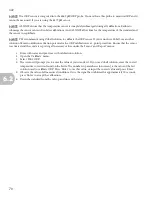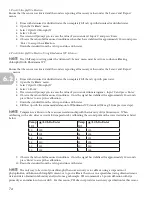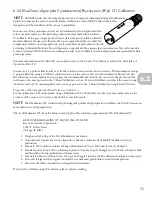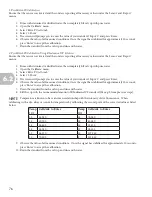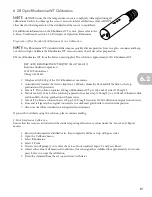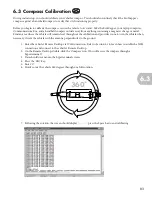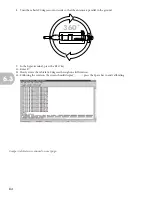
73
6.26 Chlorophyll Calibration
ALWAYS ensure that the temperature sensor is completely submerged during all
calibrations. Failure to submerge the sensor can result in false calibrations. And, ALWAYS
allow time for the temperature of the standard and the sensor to equilibrate.
In most cases chlorophyll sensors are not calibrated prior to deployment but
rather the performance is checked using a fluorescent dye and a blank solution.
To ‘calibrate’ a chlorophyll probe, discrete water samples should be collected from
the field. At the time of collection, the sensor signal should be recorded. The sample
must then be stored properly and processed in the lab according to Standard Methods. This will generate a quantitative
chlorophyll
a
concentration. The lab readings are then correlated with the field sensor readings in order to post-
calibrate the data and provide semi-quantitative chlorophyll
a
data.
For more information on the Chlorophyll sensor, please refer to the 6-Series User Manual, section 5.16, Principles of
Operation-Chlorophyll.
To check performance with a fluorescent dye, YSI recommends using Rhodamine WT solution. The dye does not
necessarily increase the accuracy of the sensor; it is used as a check of the sensor’s function. The following section
explains how to prepare the recommended solution. If you wish to simply zero out the instrument, you may
proceed to the ‘1-Point Calibration’ section.
Preparation of Dye Standard for Chlorophyll Sensor Performance Check
The Rhodamine WT standard can photodegrade quickly after preparation. Calibrate the chlorophyll sensor
no more than 24 hours after preparation.
YSI uses Rhodamine WT from the below-noted supplier. The solution is approximately 2% Rhodamine WT.
Rhodamine WT Dye (Lot# 257201; 16 Fl. Oz.)
Kingscote Chemicals
9676 N. Looney Road
Piqua, OH 45356
1.800.394.0678
Fax: 937.773.7994
1. Transfer exactly 5.0 mL of Rhodamine WT solution into a 1000 mL volumetric flask.
2. Fill the flask to the volumetric mark with either deionized or distilled water.
3. Mix well to produce a solution that is approximately 100 mg/L of Rhodamine WT. Transfer this standard to a
glass bottle and retain for future use.
4. Transfer exactly 5.0 mL of the above-prepared solution (100 mg/L) to a 1000 mL volumetric flask and then
fill the flask to the volumetric mark with deionized or distilled water.
5. Mix well to obtain a 0.5 mg/L Rhodamine WT solution in water (200:1 dilution of the concentrate). This will
be the dye standard for chlorophyll calibration.
6. Transfer the solution to a glass bottle and refrigerate it to retard decomposition.
If you wish to calibrate using this solution, please continue reading.
NOTE
NOTE
6.2












